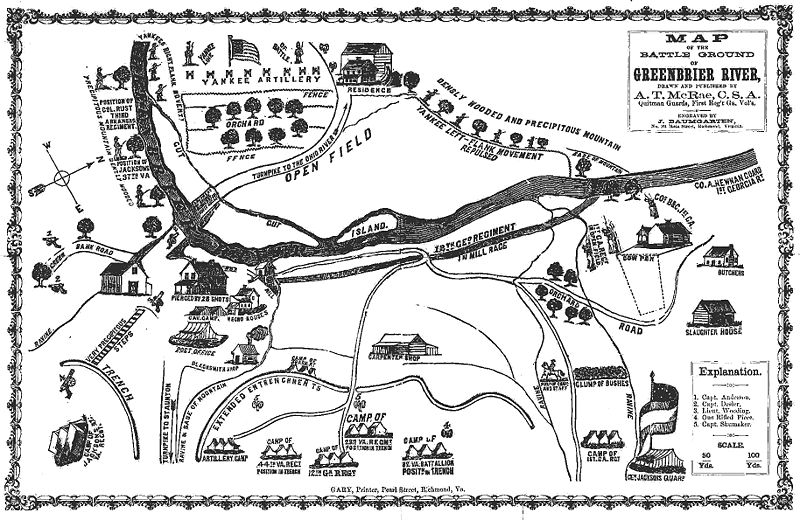Saturday, December 31, 2011
1862
As tomorrow the Year 2012 begins, on this blog we will begin our study of 1862. 1862 was a very important year in the Civil War. Expect to see a lot more posts on this blog, as the war expands to more fronts, and historic battles take place one after the other, from the battle of the Ironclads, the Monitor and Merrimack, to Jackson's brilliant campaign in the Shenandoah Valley, to the fierce defense of Richmond in the Seven Days campaign and the Confederacy will launch their first invasion of the North. New heroes will rise, and battles will be won and lost that will change the course of the war. I would love for you to comment or email me with any suggestions you might have. Feel free to subscribe by email or RSS feed and join us for this journey over the next year.
Labels:
news
Monday, December 26, 2011
Trent Affair Resolved
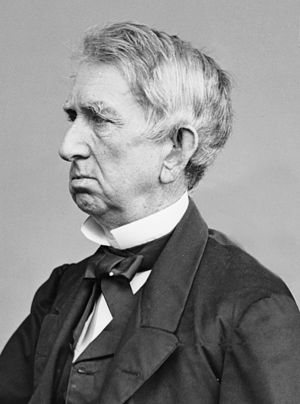 |
| William Seward, Secretary of State |
The passions of the country are up and a collision is inevitable if the Government of the United States should, before the news reaches the other side, have assumed the position of Captain Wilkes in a manner to preclude the possibility of explanation. … Ministers and people now fully believe it is the intention of the [U.S.] Government to drive them into hostilities.The Confederacy's best chance for victory would be to have European nations as Allies, as the French helped the Americans during the War for Independence. But after several cabinet meetings, the United States finally unanimously decided to free the prisoners. The actions of Captain Wilkes, who had captured the prisoners, were disavowed and Mason and Slidell were released, 150 years ago today.
Labels:
dipolmacy,
England,
William Seward
Tuesday, December 20, 2011
Battle of Dranesville
Since the battle of Balls Bluff in October there had been no major movement by either side. However, from time to time small groups were sent out to probe the enemy's lines and forage for supplies. One hundred and fifty years ago today, J.E.B Stuart went on one of these raids towards Dranesville, VA. He led 4000 troops: a brigade of infantry, 150 cavalry troopers and a 4 gun battery.
The Federal General Ord was in the area with 5,000 troops from the 3rd Brigade of Pennsylvania reserves.
As Stuart approached Dranesville from the South, he found the Federals occupying the ridge he intended to hold east of the town. The artillery on both sides opened fire. The Federal guns had a better position, and quickly overpowered the Confederate artillery. Both sides formed up their infantry and the Confederates began to make progress on the center of the line. A South Carolina regiment came upon a body of troops from Kentucky hidden in a thicket. Both sides exchanged volleys, and several were hit before the friendly fire was stopped.
The Union General Reynolds who was arriving planned to strike the Rebels on the flank, which would have driven them from the field very easily. But before the flank attack struck, Stuart pulled his infantry back, having brought his wagons to safety and knowing that they had no hope of victory with more Northern troops on the way. Ord wrote this of his victory:
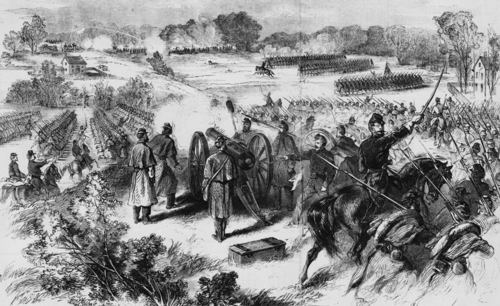 |
| Union Artillery |
The Union General Reynolds who was arriving planned to strike the Rebels on the flank, which would have driven them from the field very easily. But before the flank attack struck, Stuart pulled his infantry back, having brought his wagons to safety and knowing that they had no hope of victory with more Northern troops on the way. Ord wrote this of his victory:
“My artillery slaughtered them – while they were cooped up & jammed in a road which I raked. It was the old story – they had an ignoramus for a general, a fool for an artillery capt’n, took it for granted we would run, made no reconnaissance, posted their artillery just where I would have place it to smash it soonest….”Although Stuart had gotten the worst of this battle, he would soon prove to be one of the Confederacy's most able generals. This was the North's first victory in the east. The Confederates suffered 230 casualties, while inflicting only 71.
Labels:
battle,
J. E. B. Stuart,
Virginia
Wednesday, December 14, 2011
Battle of Allegheny Mountain
150 years
ago today Union and Confederate forces met on Allegheny Mountain in
West Virginia. Col. Edward Johnson of the 12th Georgia was
stationed on Allegheny Mountain with 1200 men to defend a strategic
road. They were attacked at dawn on the 13th by a force of
1300 men under Brigadier General Milroy.
Johnson was
alerted to the advance of the Federals up the mountain by his
pickets, and had time to form his men up. Along most of the front
they had been able to construct field entrenchments. The fighting
continued fiercely throughout the morning and early afternoon, with
the Southerners getting the worst of it because their positions were
more exposed. On the right the Confederates by hard fighting began to
gain the upper hand. One officer reported:
By
this time the extreme right had been forced back, but ... they ...
moved upon the enemy, who, taking advantage of some fallen trees,
brush, and timber, poured upon them a terrific fire. Our men were
checked, but not driven back. They did not yield an inch, but
steadily advanced, cheered and led by their officers. Many of the
officers fought by the side of their men and led them on to the
conflict. I never witnessed harder fighting. The enemy, behind trees,
with their long-range arms, at first had decidedly the advantage, but
our men soon came up to them and drove them from their cover. I
cannot speak in terms too exaggerated of the unflinching courage and
dashing gallantry of those 500 men who contended from 7.15 a.m. until
1.45 p.m. against an immensely superior force of the enemy, and
finally drove them from their positions and pursued them a mile or
more down the mountain.
One soldier
remembered this sight he got of Johnson:
I had a
splendid position in this battle and could see the whole fight
without having to take any part in it, and I remember how I thought
Colonel Johnson must be the most wonderful hero in the world, as I
saw him at one point, where his men were hard pressed, snatch a
musket in one hand and, swinging a big club in the other, he led his
line right up among the enemy, driving them headlong down the
mountain, killing and wounding many with the bayonet and capturing a
large number of prisoners...
After the
battle, the Union forces reported a victory over superior numbers,
but the Confederates remained undefeated holding their same position
on Allegheny Mountain. For this hard fight Johnson was promoted to
Brigadier General and gained the nickname Allegheny Johnson. This was
a very bloody fight for the lower number of forces engaged. The
Northerners suffered 20 killed 107 wounded and 10 missing, while the
Confederates had 20 killed, 98 wounded and 28 missing.
Labels:
battle,
West Virginia
Monday, December 5, 2011
Lincoln's Annual Address
On December 3rd, 1861, Lincoln issued is Annual Address, the equivalent of the State of the Union. He addressed many specific actions that had been taken, in this year, the most disastrous for the American Union. You can read the complete speech here. He closed saying this:
There are already among us those who if the Union be preserved will live to see it contain 250,000,000. The struggle of to-day is not altogether for to-day; it is for a vast future also. With a reliance on Providence all the more firm and earnest, let us proceed in the great task which events have devolved upon us.
Labels:
Abraham Lincoln,
politics,
speech
Thursday, December 1, 2011
England Protests the Trent Affair
 |
| Lord Lyons, the British Ambassador |
It thus appears that certain individuals have been forcibly taken from on board a British vessel, the ship of a neutral power, while such vessel was pursuing a lawful and innocent voyage—an act of violence which was an affront to the British flag and a violation of international law.
Her Majesty's Government bearing in mind the friendly relations which have long subsisted between Great Britain and the United States are willing to believe that the U. S. naval officer who committed the aggression was not acting in compliance with any authority from his Government, or that if he conceived himself to be so authorized he greatly misunderstood the instructions which he had received; for the Government of the United States must be fully aware that the British Government could not allow such an affront to the national honor to pass without full reparation, and Her Majesty's Government are unwilling to believe that it could be the deliberate intention of the Government of the United States unnecessarily to force into discussion between the two Governments a question of so grave a character and with regard to which the whole British nation would be sure to entertain such unanimity of feeling.
Her Majesty's Government therefore trust that when this matter shall have been brought under the consideration of the Government of the United States that Government will of its own accord offer to the British Government such redress as alone could satisfy the British nation, namely, the liberation of the four gentlemen and their delivery to your lordship in order that they may again be placed under British protection and a suitable apology for the aggression which has been committed.
Thursday, November 24, 2011
1861 Thanksgiving
 |
| Thanksgiving celebration, 1861 |
On Thanksgiving 1861, the New York Independent published this, putting aside for the moment the war that was raging throughout the continent:
We did not need a proclamation by the Governors to call us to Thanksgiving for the bounties of the year. Thanksgiving is already proclaimed by Him “who openeth his hand and satisfieth the desire of every living thing.” The earth is keeping her harvest festival. From hillsides clothed with grain, from meadows covered with fattening flocks and herds; from valleys and prairies waying with corn; from orchards teeming with golden and crimson fruits; from barns bursting with plenty, and dairies dripping with fatness; there goes up the universal chorus, Praise ye the Lord. The trees clap their hands, the little hills rejoice on every side; the valleys shout for joy, they also sing.
What generous crops of hay for the cattle of the field! What a large yield of wheat and corn – estimated at a thousand million bushels already in the graneries! Our garners are full, affording all manner of store; the land floweth with milk and honey. We seem to hear the myriad voices of Nature crying, “Oh that men would praise the Lord for his goodness, for this wonderful works to the children of men. Let them sacrifice the sacrifices of thanksgiving, and declare his works with rejoicing. For he satisfieth the longing soul, and filleth the hungry soul with goodness.
Wednesday, November 23, 2011
Bombardment at Pensacola, Florida - Day 2
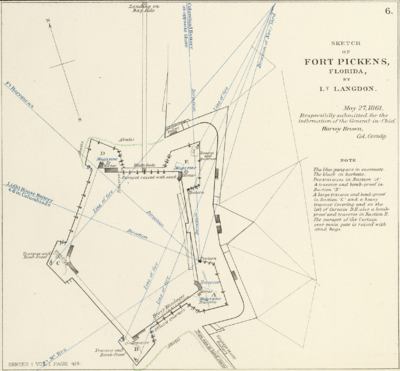 |
| Map of Fort Pickens |
The fire from the enemy’s batteries was heavy and well directed. There were many marvelous escapes from wounds. Among the most notable was that of Lieutenant Shipley, Third Infantry, and the detachment serving the 10-inch columbiad en barbette of his battery. A 10-inch shell struck the shell-proof and burst among his men and himself without wounding any one, although the sand and sand bags were knocked down over and around them.
 |
| USS Richmond |
But in giving this praise to human virtue let us not be unmindful of an invisible Power, which has ruled all things for our good. The hand of disease and death has been lightly laid upon us at a place and in a season when we had reason to expect much suffering and great mortality. And in the hour of our trial the missiles of death, showered upon us by an infuriated enemy, respecting neither women, children, nor the sick, have been so directed as to cause us to laugh at their impotent rage. Verily, “Except the Lord keep the city, the watchman waketh but in vain.”
 |
| Fort Pickens |
Labels:
bombardment,
Florida,
navy
Tuesday, November 22, 2011
Bombardment at Pensacola, Florida
| The Forts in Pensacola Bay |
 |
| Fort Pickens |
Darkness closed the contest, which had lasted for more than eight hours without an intermission. For the number and caliber of guns and weight of metal brought into action it will rank with the heaviest bombardment in the world. It was grand and sublime. The houses in Pensacola, 10 miles off, trembled from the effect, and immense quantities of dead fish floated to the surface in the bay and lagoon, stunned by the concussion. Our troops behaved with the greatest coolness and gallantry, and surprised me by the regularity and accuracy of their firing, a result which would have been creditable to veterans.
 |
| Fort Barrancas |
The barrage continued all day, with the Union forces getting the best of the fight. Fort McRee's guns were silenced, and there was a little damage to the other fortifications. The fight would continue the next day.
 |
| Fort Barrancas today |
Labels:
battle,
Florida,
fort,
Fort Pickens,
navy
Saturday, November 19, 2011
Jefferson Davis on the Trent Affair
 |
| Jefferson Davis |
"[N]ot content with violating on the rights under the law of nations at home, they have extended these injuries to us within other jurisdictions. The distinguished gentlemen whom, with your approval, at the last session, I commissioned to represent the Confederacy at certain foreign Courts, have been recently seized by the captain of a United States ship-of-war, on board a British steamer.... These gentlemen were as much under the jurisdiction of the British Government upon that ship, and beneath its flag, as if they had been upon its soil; and a claim on the part of the United States to seize them in the streets of London would have been as well founded as that to apprehend them where they were taken."
Labels:
Jefferson Davis,
retreat
Saturday, November 12, 2011
The Trent Affair Begins
Wesaw a few months ago how Mason and Slidell were appointed as
Confederate ambassadors to European nations. Their job was to
convince France and England to recognize the Confederacy as a nation
and assist them in securing their independence.
But
getting over to Europe was not easy for Mason and Slidell, since most
of the Confederacy's ports were blockaded by the large Union fleet.
Early on the morning of October 12th, they were able to
avoid the Union fleet off Charleston. They stopped in Cuba, and left
on the British mail ship the Trent on
November 7th.
 |
| Wilkes |
Pursing Mason and Slidell was Captain Charles Wilkes. He knew that it
was important to the war that the Confederates not convince England
to ally with them, and he decided the best way to do that was to
capture the ambassadors before they arrived. He had an reputation as
a reckeless officer, and Seward in Washington had been warned, “He
will give us trouble. He has a superabundance of self-esteem and a
deficiency of judgment. When he commanded his great exploring mission
he court-martialed nearly all his officers; he alone was right,
everybody else was wrong.”
On
November 8th,
Wilkes caught the Trent
as it was leaving Cuba. The Trent
was neutral and would make no resistance even though they viewed the
search by the Americans as illegal. Mason and Slidell were taken off
the Trent, after
formally refusing to come and being brought by an armed guard. This
moment would seem very low for the Confederacy. But although their
ambassadors were captured, it was a blessing in disguise. The Trent
Affair would bring England to the very edge of war with the United
States.
Thursday, November 10, 2011
"Massacre" of Guyandotte
A regiments of about 150 Unionists was training in the town of Guyandotte, now West Virginia. The townspeople, not liking to have the Federals among them, called in a group of 700 Confederate cavalry. At 7 pm they surrounded the town and attacked. The Confederates were successful in capturing 70 of the Federals. A few dozen were killed on either side. Reports of cruelty began circulating immediately. By the time the New York times printed the “details” of the event, facts were mostly absent from the account.
There were, it seems, stationed as a guard in the town something less than three hundred Union troops, all Virginians. The most of these the rebel inhabitants, by dint of delusive demonstrations of kindly feeling and anxious hospitality, beguiled to their houses on the evening in question, and then by a display of signals, announced to the guerilla cavalry of Ex-Congressman Jenins, lurking in the neighborhood, that the unconscious victims were garlanded for the slaughter. The butchers, five hundred in number, dashed into the town, fell upon the unarmed National soldiers, and after killing a number, as yet unascertained, made captives of the remainder, those only who had declined the hospitality of the conspirators escaping. While the fight was proceeding, the rebel population, male and female, assisted the destruction by firing from the windows upon their betrayed guests.
Had the possibility of reviving on any theatre of war in the nineteenth century the dramas of the Sicillian Vespers, St. Bartholomew's Night, and Glencoe, been preasserted, an outraged civilization must have pronounced the assertion a slander upon the age. Yet the spirit which suggested this Guyandotte massacre is even worse than that which prompted either of the three great tragedies referred to. The slain at Palermo were merciless foreign oppressors; at Paris, professors of a heresy which the murderers deemed it a sacred obligation to extirpate; in Scotland, outlaws whom the soldiery were under strict military orders to slay. But the victims at Guyandotte were the immediate brethren of the butchers; natives not only of the same country, but of the same State; differing neither in race or faith, differing only in opinion upon a question wholly political and social. That so devilish a plot should have been devised against such, and so pitilessly executed, is a fact only possible of a people whose institutions are essentially barbarous, the negative of right and clemency, the incarnation of all there is treacherous and cruel in unregenerated human nature.
Labels:
massacre,
press,
West Virginia
Monday, November 7, 2011
Battle of Belmont
 |
| Map of the Battle of Belmont |
Grant landed his forces three miles north of Belmont, after being brought down by a small fleet from Cairo, Missouri. They were delayed in their march south because of obstructions that the Confederates had placed in the road. By the time they were in line of battle to attack, Pillow's entire division was in place from across the river. Both sides were green, and the fighting raged back and forth throughout the rest of the morning. By 2 pm the Confederates began to get the worst of the fight, and running low on ammunition, Pillow ordered a charge. It was poorly executed, and Grant drove them into a rout. The Federal cannon opened on the Confederates, and they abandoned their camp, colors and cannon to Grant's victorious troops. But the green Union army soon became just as disorganized by the Confederates in the rejoicing over their victory.
General Polk landed Confederate reinforcements from across the river North of Belmont, cutting of Grant's line of retreat. Grant later wrote:
The guns of the enemy and the report of being surrounded, brought officers and men completely under control. At first some of the officers seemed to think that to be surrounded was to be placed in a hopeless position, where there was nothing to do but surrender. But when I announced that we had cut our way in and could cut our way out just as well, it seemed a new revelation to officers and soldiers. They formed line rapidly and we started back to our boats, with the men deployed as skirmishers as they had been on entering camp. The enemy was soon encountered, but his resistance this time was feeble.1There were not enough Confederates on hand to put up a line strong enough to resist the Union attacks, and Grant was successful in bringing his men back to the transports.
Both sides claimed victory, but the battle was actually inconclusive and proved nothing other than Grant was willing to fight. Both sides suffered similar casualties, around 100 killed, 400 wounded and 100 captured.
1. Personal Memoirs of U. S. Grant by Ulysses S. Grant (New York: Charles L. Webster & Company, 1885) p. 276
Labels:
battle,
landing,
Missouri,
navy,
Ulysses S. Grant
Battle of Port Royal
 |
| Flag Officer Du Pont, Union Naval Commander |
 |
| Map of Port Royal |
For the attack on Port Royal the North assembled what was, up to that point, the largest fleet to sail under the American flag, with 19 warships and 68 other ships. On the way to Port Royal, on November 1, the fleet was struck with a storm. The fleet was scattered and four ships were sunk. By November 4 the fleet was reassembled, except for a few ships which had to return home for repairs. Some naval skirmishing occurred on November 4 and 5, which showed that the Confederate gunboats would do little in the face of the powerful Federal vessels. The Union army commander also informed the fleet commander that the army could not participate in the attack because the lost ships contained necessary ammunition. Flag Officer Du Pont, the fleet commander, decided to go on with the naval attack. The battle was delayed until November 7th because of bad weather. Du Pont decided to go with a strategy similar to that used at the Battle of Hatteras Inlets. He would have his ships bombard while moving, hoping to thus avoid the forts' fire.
 |
| Bombarding Port Royal |
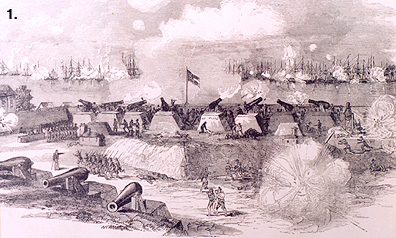 |
| Confederate Fort Receiving the Union Fire |
The casualties were relatively light in this battle, with 11 Confederates dead and 47 wounded, and with the Union fleet having 8 killed and 23 wounded. Although this battle has largely been forgotten, it had an important effect on the flow of the war. A Union author wrote:
The Battle of Port Royal Bay has been somewhat overshadowed by the later naval victories of the war, but at the same time it was admirably planned and brilliantly executed. It was a battle in which ships engaged and captured forts on shore which were supposed to be impregnable to attack from the sea, for the army remained on board its transports and took no hand in the fighting, not landing until the forts had been abandoned under the fire of the naval guns. It had a good moral effect, for it came at a time when the Confederate arms had been generally successful and the feeling of despondency at the North was widespread, and this effect was felt abroad as well as at home. The object for which the expedition set out had been perfectly successful, and the plan carried out in its entirety, without hitch or mistake.11. Biographical Memoirs (Washington City: National Academy of Sciences, 1895), vol. III, p. 36
Labels:
battle,
blockade,
Confederate Navy,
fort,
navy,
South Carolina
Friday, November 4, 2011
Jackson Bids His Troops Farewell
150 years ago today Stonewall Jackson bid farewell to his command, the Stonewall Brigade with whom he had gained fame at the Battle of Manassas. He was being moved to the Shenandoah Valley, where he would gain undying laurels in 1862. Before leaving his brigade, he issued this order:
You were the First Brigade in the Army of the Shenandoah, the First Brigade in the Army of the Potomac, the first Brigade in the Second Corps, and are the First Brigade in the hearts of your generals. I hope that you will be the First Brigade in this, our second struggle for independence, and in the future, on the fields on which the Stonewall Brigade are engaged, I expect to hear of crowning deeds of valor and of victories gloriously achieved! May God bless you all! Farewell!
Labels:
Shenandoah Valley,
Stonewall Jackson
Monday, October 31, 2011
General Winfield Scott Retires
150 years ago today General Winfield Scott retired as commander of the United States Army. There had been increasing tensions between Scott and George B. McClellan, commander of the main Union army. Scott wrote this in his letter of resignation:
“For more than three years I have been unable, from a hurt, to mount a horse or walk more than a few paces at a time, and that with much pain. Other and new infirmities, dropsy and vertigo, admonish me that a repose of mind and body, with the appliances of surgery and medicine, are necessary to add a little more to a life already protracted much beyond the usual span of man. It is under such circumstances, made doubly painful by the unnatural and unjust rebellion now raging in the southern states of our so late prosperous and happy Union, that I am compelled to request that my name be placed on the list of army officers retired from active service.”He passed over the tensions with McClellan, but they were certainly a large part of his decision to resign. It had come to the point that McClellan referred to it as a war between him and Scott. Scott told McClellan this: "When I proposed that you should come here to aid, not supersede, me, you had my friendship and confidence. You still have my confidence.”
Scott retired as a man who had spent his life in service to his country. He had fought with high rank in both the War of 1812 and the Mexican War, but by the time of the Civil War he had outstayed his welcome. It was believed that new blood was needed to win the war, but just how well that new blood would preform still remained to be seen.
Labels:
general,
George McClellan,
politics,
Winfield Scott
Friday, October 21, 2011
Battle of Ball's Bluff
150 years ago today the Battle of Ball's Bluff was fought. It was the second largest battle in the eastern theater in 1861, and it was another Union defeat. On October 20th, a Union scouting party was sent across the Potomac River from Maryland to investigate some rumors of a Confederate retreat in the area. In the dim evening light, an inexperienced Union officer mistook a row of trees for an unguarded Confederate camp. Acting on this information, a raiding party of 300 men was sent the next morning to attempt to capture it.
Finding that the report about the Confederate camp was false, the raiding party reported back and waited for orders. Colonel Edward Dickinson Baker, a US senator, was sent to decide whether to reinforce the party and continue to advance, or have them retreat back across the river. Baker ended up ordering all the available troops in the area to cross the river. This crossing was very slow because of the few number of boats. Meanwhile, the reinforced raiding party engaged in several skirmishes with Confederate troops, and at 2:00 PM they fell back to the troops who had crossed the river and formed up along the bluff.
 |
| Col Baker killed |
"[I]t seemed impossible to preserve the order necessary for a combined military movement, and Colonel Cogswell reluctantly gave the order to retreat to the river-bank. The troops descended the bluff, and reached the bank of the river, where there is a narrow plateau between the river and the ascent of the bluff, both the plateau and the bluff being heavily wooded. As I descended upon this plateau, in company with Colonel Cogswell, I saw the large boat, upon which we depended as the means of crossing the river, swamped by the number of men who rushed upon it. ... It was impossible to continue to resist, and I should have had no doubt, if we had been contending with the troops of a foreign nation, in justice to the lives of men, it would have been our duty to surrender; I had no hesitation in advising men to escape as they could, ordering them in all cases to throw their arms into the river rather than give them up to the enemy. ... [A]t dark [I] swam the river by the aid of three of three soldiers of my regiment."1
The broken Union troops paniced and rushed toward the river. There was no way they would be able to cross the river in such a few number of boats. So many men piled into the ones that they did have that they quickly capsized. Many were drowned or were shot trying to cross the river. In this chaos 223 Union troops were killed, 226 wounded and 553 captured, a very high number for the less than 2000 engaged. The Confederates lost only 155.
 |
| Senator Col. Baker |
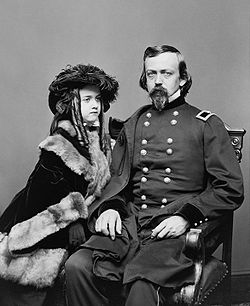 |
| General Stone |
1. Battles and Leaders of the Civil War, vol. 1, p. 130
Thursday, October 20, 2011
Before the Monitor – Development of Naval Technology
We have seen over the past few months how both the Confederate and Union armies began constructing iron plated vessels to either break or preserve the blockade. These construction efforts resulted in the first ironclad against ironclad battle in world history between the Monitor and the Merrimac in March, 1862. Some have mistakenly identified these ships as the first ironclads, but if we look at the naval history of the previous decades, we find this is was not the case. For example, the Young People's History of the United States from 1916 contained this:
The idea of covering ships with iron was not new. It had been around in various forms for centuries, but there were several restraints on their actual construction. Steam propulsion was really necessary to create a useable ironclad or floating batteries. Wind and sails just did not have the power to move an iron covered ship. Some of the first forerunners of the ironclads were called floating batteries. Floating batteries were ships with heavy armaments intended to defend a stationary position. But some floating batteries were constructed which were capable of movement. During the Crimean War France and Great Britain built iron plated floating batteries which were capable of slow movement. These were used against Russian fortifications, and was one of the reasons they eventually sued for peace.
With the success of their floating batteries, in the late 1850s France began developing iron plated ships which were intended for faster movement. In 1859 La Glorie was launched, which has been called the first true ironclad. It was covered by 4.5 inches of iron, and was capable of moving at the rate of 13 knots. She was armed with 36 rifled guns. It was recognized in Europe that these were the ships of the future. Britain and France began to construct large numbers of these new ironclads, recognizing that wooden ships would be useless against them. In 1860 Britain launched the Warrior, a faster and more powerful ironclad.
By the time the Civil War started in 1861, all the nations of Europe recognized the way naval technology was going. Although it had not yet occurred, they could easily guess what would happen when these powerful new vessels met their current wooden fleets. By 1862 Britain and France had 16 ironclads completed or under construction, and Austria, Italy, Russia and Spain were building them as well. As the Civil War began, the Confederacy began to construct ironclads in hope that they would be able to use them to break the blockade of the North. The Federals followed suit and began building ironclads of their own.
We have already discussed the Battle of Head of Passes, the first time a true ironclad entered combat. But this battle did not show the full potential of ironclads, since the wooden ships did not put up a good showing. That showdown would not occur until March 9th and 10th, 1862, when the Merrimac struck the Union fleet, and then encountered the Monitor off Hampton Roads, Virginia.
So although ironclads had not proved everything they were capable of until the battle of the Monitor and Merrimac, all the navies of Europe had already guessed it and had many ironclads under construction.
Until our Civil War, all ships, even ships of war, were made of wood. Now, they are made of steel. A single sea-fight changed the great ships of the world from wood to steel,— the fight between the Monitor and the Merrimac.In this post I will go over some of the naval technological development so that we can understand the true significance of ironclads in the Civil War.
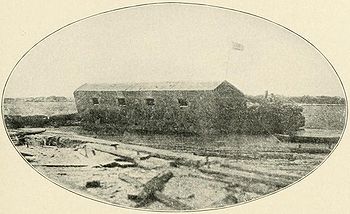 |
| Floating Battery from Charleston Harbor |
 |
| La Glorie, first oceangoing ironclad |
With the success of their floating batteries, in the late 1850s France began developing iron plated ships which were intended for faster movement. In 1859 La Glorie was launched, which has been called the first true ironclad. It was covered by 4.5 inches of iron, and was capable of moving at the rate of 13 knots. She was armed with 36 rifled guns. It was recognized in Europe that these were the ships of the future. Britain and France began to construct large numbers of these new ironclads, recognizing that wooden ships would be useless against them. In 1860 Britain launched the Warrior, a faster and more powerful ironclad.
 |
| British Ironclad Warrior today |
 |
| CSS Manassas |
So although ironclads had not proved everything they were capable of until the battle of the Monitor and Merrimac, all the navies of Europe had already guessed it and had many ironclads under construction.
Labels:
Confederate Navy,
navy,
technology
Wednesday, October 12, 2011
Battle of the Head of Passes
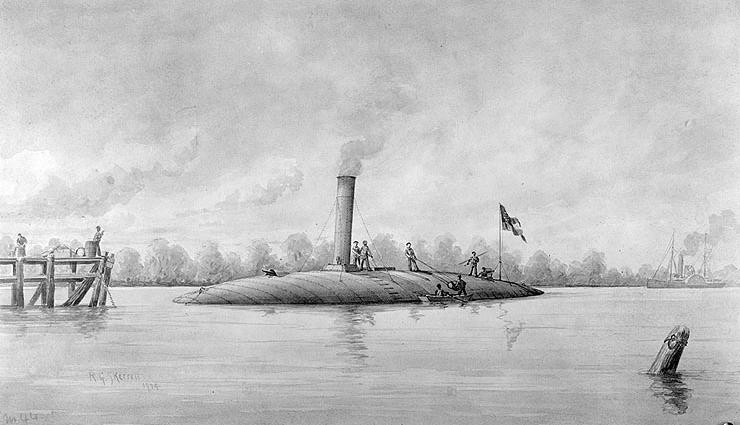 |
| CSS Manassas |
 |
| USS Richmond |
 |
| Manassas attacks the Richmond |
 |
| Map of Head of Passes |
Put this matter in any light you may, it is the most ridiculous affair that ever took place in the American Navy. There is no instance during the war like it. To think that we should have to write of such a retreat is mortifying, but it stands on record, described in language that almost claims merit for the flight of the "Richmond" and her consorts, chased by a ram that was going in an opposite direction as fast as her disabled machinery would take her,— her officers thanking their stars that they got away so easily! There is nothing that can equal the comicality of Capt. Handy's performance—laying a train with a slow match to his magazine, and then hastening away in his boats with the American flag wound around him, and his remarkable antics when he found that his ship would not blow up. This presents an example unmatched in any navy in the world.This conflict has been forgotten in the light of the more illustrious battle of the Monitor and the Merrimack. Because of the damage to the Manassas the true abilities of the ironclad were not demonstrated. However, the capture of New Orleans was put off until a later date.
Labels:
battle,
blockade,
Confederate Navy,
Louisiana,
navy,
New Orleans,
technology
Sunday, October 9, 2011
CSS Ivy Attacks Near New Orleans
 |
| Cannon like that on the Ivy |
U. S. S. Richmond,
Mississippi River, October 9, 1861
Respectfully, your obedient servant,
John Pope,
Captain 1
1. Official records of the Union and Confederate Navies in the War of the Rebellion, I, v. 16, p. 699 - 700
Labels:
Confederate Navy,
Louisiana,
Mississippi River,
navy,
New Orleans
Monday, October 3, 2011
The Battle of Greenbrier River
150 years ago today the Battle of Greenbrier River was fought in West Virginia. Here is a letter an Indiana soldier wrote the next day recounting their attack on the Confederate camp.
Army of Occupation Camp, On Cheat Mountain, Oct. 4, 1861.The battle did not go as well for the Union side as their soldier recounted. At the end of the day they retreated back to where they had come, unable to take the Confederate position.
Friend Greene: Thursday noon we were ordered to prepare two days' rations and bold ourselves in readiness to march at midnight. Up to 9 o'clock camp fires burned brightly; around them groups of soldiers gathered singing, laughing, "speculating" on The coming fight. There was a constant jingle, jingle of iron ram-rods, snapping of caps, and sputtering of hot grease in sundry frying pans-notes of preparation for The morrow; 'tattoo" rolled off at 10 o'clock, one hour later than usual, and "taps" at a quarter past, when camp fires were put out; all lights except in officers' tents extinguished, and the soldiers retiring to their quarters and blankets, sought two hours' repose. At 12 o'clock all were aroused,the companies forming into Their respective quarters, were visited each in turn by our gallant Colonel, who spoke a few words of encouragement and bade them all stand by him, and remember They were from Indiana and belonged to the 14th regiment; then came the order to form in line, which movement was promptly executed. Right, face! Forward march! and the 14th taking The "route steps," moved quickly but silently down the moantam eastward, past several regiments in the dense fog, the boys shouting to each other as they filed rapidly by at Cheat River Bridge; overtook the artillery; passed it; were soon beyond our picket line, and hurrying np the opposite mountain, through the dark and silent night, without a moment's rest till the first faint streaks of light appeared in the East, when the regiment was halted, and muskets and rifles loaded; in motion again pretty soon; passed the ambulances belonging to the 9th Indiana and our own; then descending the mountain, approached The Greenbriar Bridge, when the sharp report of half-a-dozen muskets rang out on the still morning air, immediately followed by a crashing volley; then pop! pop! pop! and all was silent: on went the 14th, cheering as they rushed "double quick," over the bridge and down through the Greenbriar Valley; soon we Came in sight of The 9th Indiana boys, drawn up in line of battle, across a meadow, thdr skirmishers hastening down from the surrounding mountains to join The regiment. The 14th closed in behind, when the two regiments moved steadily forward till we came in sight of the enemy's tents, when the advance halted and the artillery moved to the front, taking up a position on a slight devation to the left of the pike, Other regiments now came up, and the 7th, 9th, and 17th Indiana boys filed across the valley, and as the right wing deploying their skirmishers advanced at "double quick" through the tall grass and bushes skirting the river and rneadows. The 14th now marched forward along the pike for a few hundred yards, when the companies comprising our left wing, including Company C, were ordered to deploy and drive The rebels out of the woods to the left, while the remainder of the regiment marched along The pike to protect the batteries.
Soon we were climbing through The tanglewood and laurel up the steep mountain sides, when bang! goes a big gun from our battery of rifled cannon, and whiz! comes a shell over our heads, falling plump into the enemy's trenches, where it burst, killing three horses and doing other damage. A roar from the rebel camp answered, and a round shot whistled through the air in reply, tearing up the ground in rear of our artillery. The ball was flow opened-roar after in quick succession from The big guns on both sides-the storm of shot and shell traversing mid air not more than fifty feet from our heads, was at once terribly grand and terrific. The fierce music of "grim war," such as had fallen npon the ears of but few of our brave fellows, who all unheeding, cheered lustily and pushed forward rapidly to the front.
The rebel skirmishers, 600 in number, were speedily rousted from cover, and the musketry now opened along our entire line on the retreating foe. To your correspondent the rapid "file firing" of the companies and the rebel shots in reply, intermingled with the deafening roar of artillery sounded like 10,000 packs of fire-crackers set off at once.
Our batteries now took up a position in front, and for three hours poured shot and shell into the enemy's camp, doing great execution. He had eleven guns (one and 18-pounder) and one mortar; seven of these were silenced, when he was reinforced with both then and guns, and reopened fire again. Our ammunition for the artillery running short, the gras were withdrawn, and at 4 o'clock we began our march back to camp. As we came out of the woods into the open space to form into line The round shot ploughed up the ground around us. Every moment bang would go a gun, whiz! boom and a shell would make The earth fly, filling the boys' eyes with gravel; but the brave fellows stood their gronnd without flinching, as formed in four ranks without a rnurmnr They cooly awaited the order to march.
The Hoosiers are too much for Secesh-fire too rapidly and with aim too accurat-nothing in rebel shape can resist their impetuosity. Silence their batteries, Mr. Big Guns, and the infantry will soon complete the job.
The loss on our side trifling-eleven killed and fifteen wounded-three of the killed and four of the wounded belonged to the 14th-none from either of the Vincennes companies. We captured 13 prisoner-our regiment, 7[,] the Invincibles 5 Bully!
A fine drove of beeves were driven off by our boys, and 15 head of horses.
Our brave Colonel Kimball asked permission to storm their works Gen. Reynolds would not grant the request, remarking that he merely came out to reconnostre the rebel positioin and draw him out, which having been accomplished to his entire satisfaction, he ordered a retreat.
Incidents in my next.
PROCK.
Labels:
battle,
West Virginia
Friday, September 23, 2011
Recounting the Dead
The New York Time's blog on the Civil War published an interesting article about counting the number of deaths from the Civil War.
Even as Civil War history has gone through several cycles of revision, one thing has remained fixed: the number of dead. Since about 1900, historians and the general public have assumed that 618,222 men died on both sides. That number is probably a significant undercount, however. New estimates, based on Census data, indicate that the death toll was approximately 750,000, and may have been as high as 850,000.Read it here.
Tuesday, September 20, 2011
Seige of Lexington
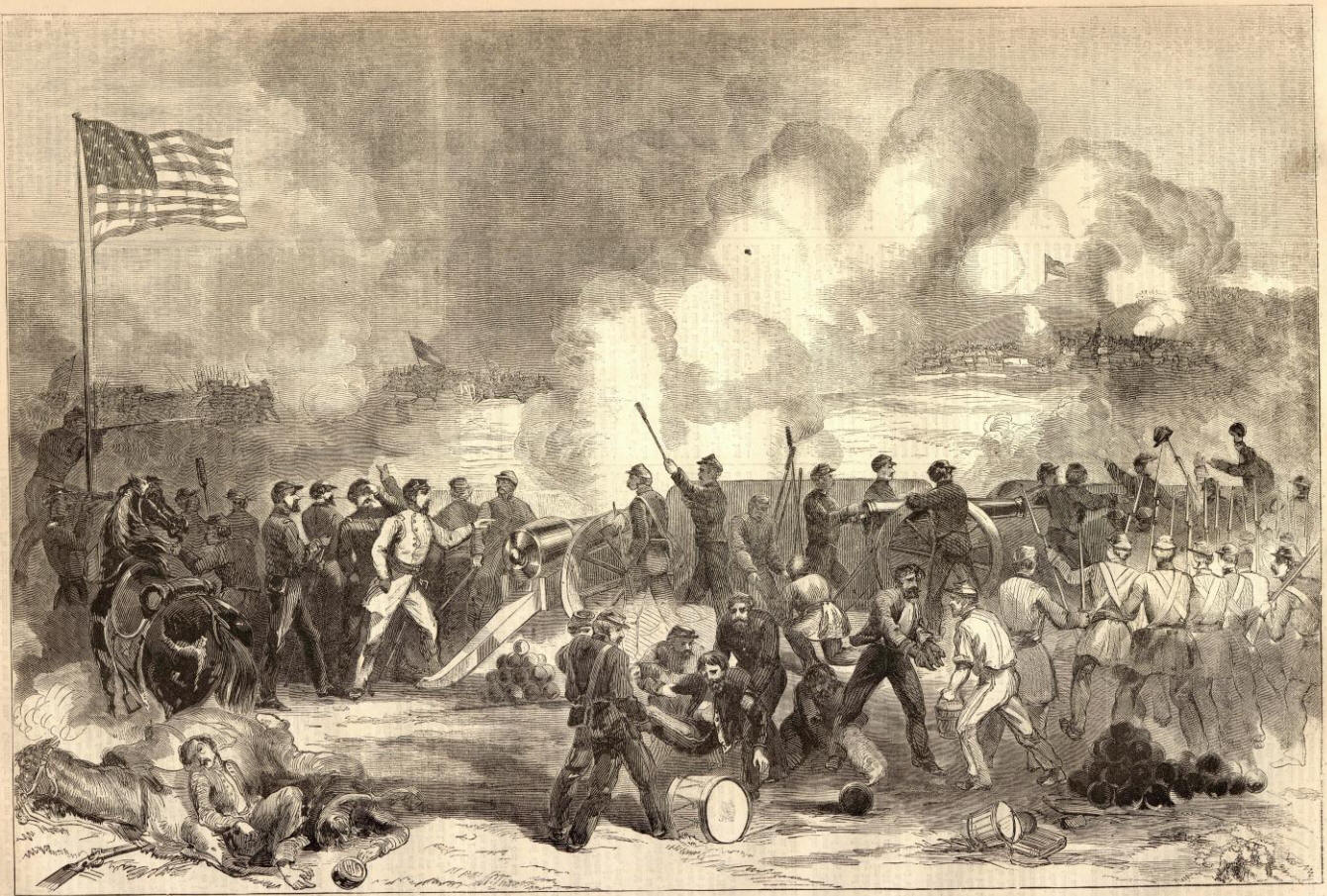 |
| Seige of Lexington |
 |
| Cannon Ball in the Lexington Court House. Credit. |
 |
| Hill up which the Confederate Forces advanced |
The casualties from the battle had been
light. The Missouri State Guard had suffered only 25 killed and 72
wounded, while the Federal forces had 39 killed and 120 wounded, with
their entire force being taken prisoners. The light casualties of the
defenders resulted from the brilliant idea of using the soaked bales
as movible defenses. Jefferson Davis later wrote, "The expedient
of the bales of hemp was a brilliant conception, not unlike that
which made Tarik, the Saracen warrior, immortal, and gave his name to
the northern pillar of Hercules."
 |
| Much fighting took place over this house. Credit. |
Monday, September 12, 2011
Battle of Cheat Mountain
 |
| Earthworks on Cheat Mountain |
Labels:
battle,
Robert E. Lee,
West Virginia














